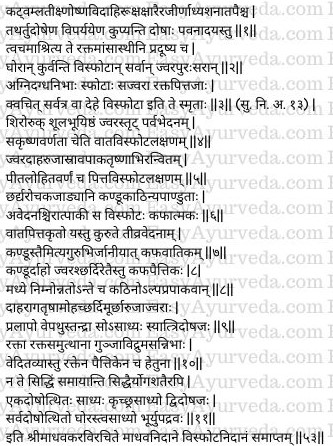Madhava Nidana Chapter 53 Visphota Nidanam

This article explains Madava nidana 53rd chapter “Visphota Nidanam”. Causes, pathology and symptoms of Visphota are explained in this chapter. Visphota means blister.

Table of Contents
Nidana, Samprapti
Etiological factors and pathogenesis of Visphota
Etiological Factors – excessive indulgence in foods which are pungent and sour in taste, penetrating, hot, those producing burning sensation (corrosive), dry, alkaline, uncooked and in excessive quantity, exposure to sun-light, bad effects of seasons (due to exposure to excessive heat, wind, cold etc.) and abnormal seasons (excessive cold in summer, excessive cold in summer etc.) are the etiological factors of visphota.
Pathogenesis – The above said etiological factors cause aggravation of vata and other doshas (pitta, kapha). These doshas in turn get lodged in the skin and contaminate blood, muscles and bones and produce many dreadful vesicles on the skin preceded by fever. (This condition is called visphota). (1-2)
Read – Visphota: Causes, Types, Treatment, Medicines

Nature of Visphot
Vesicles resembling boils formed by the touch of fire (boils which occur due to fire burns), caused by aggravation of blood and pitta, associated with fever, occurring in some or all the parts of the body is known as Visphota. (3)
Symptoms of doshaja visphota
Vataja Visphota – The symptoms of visphota caused by predominance of vata are headache, severe pain, fever, thirst, splitting pain in the small joints of the hands and feet and the manifestation of vesicles which are black in colour.
Pittaja Visphota – The symptoms of visphota caused by predominance of pitta are – fever, burning sensation, pain, discharges (exudates), suppuration (formation of pus), thirst and formation of vesicles which are yellow or red in colour.
Kaphaja Visphota – The symptoms of visphota caused by predominance of kapha are – vomiting, loss of taste, lassitude, itching, hardness, pallor, lack of pain and formation of vesicles which undergo slow suppuration.
Vata-pittaja Visphota – presents with severe pain.
Vata-kaphaja Visphota – presents with itching, feeling of being covered with wet leather or cloth and heaviness.
Kapha-pittaja Visphota – presents with itching, burning sensation, fever and vomiting. (4-7)
Read – Blisters: Ayuvedic Understanding, Treatment Principles
Sannipataja Visphota
The visphota (vesicles) caused by simultaneous aggravation of all the three doshas will have depression in the centre and are elevated at the edges, are hard and undergo less suppuration (with little quantity of pus in them). This condition is associated with burning sensation, redness, thirst, delusion, vomiting, fainting, pain, fever, delirium, tremors, and stupor. This condition is incurable. (8-9)
Raktaja Visphota
Visphota caused by rakta (vitiated blood) will have vesicles which are red in colour resembling guñjā seed (Abrus precatorius) or coral bead. They are caused by blood vitiated by pitta aggravating etiological factors. They do not respond to any kinds of treatments even by administering hundreds of efficient recipes. (10)
Read – Ayurvedic Treatment For Blisters, Medicines, Herbs, Personal Experience
Prognosis of Visphot
Visphota caused by single dosha is curable.
Visphota caused by simultaneous aggravation of two doshas is curable with difficulty.
Visphota caused by simultaneous aggravation of all the three doshas and that which is associated with complications is incurable. (11)
Thus ends the chapter on Visphota Nidanam in Madhava Nidana text written by Acharya Madhavakara.










